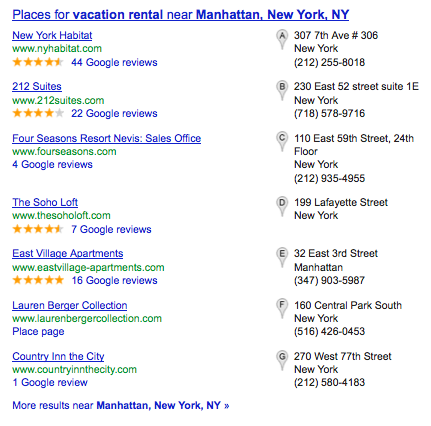Why You Should Love the Long Tail
 Are you looking for more Google love?
Are you looking for more Google love?
Want to drive highly qualified traffic?
Do you want to reach readers at all phases of the purchase cycle?
You got it. All you have to do is learn how to leverage the long tail.
Google just announced another algorithm tweak, and this time, it’s targeting long-tail documents. According to the Google Inside Search blog:
“More comprehensive indexing: This change makes more long-tail documents available in our index, so they are more likely to rank for relevant queries.”
What does this mean to you (and your clients?) Plenty.
Long tail search queries are hidden nuggets of search engine gold. These multi-word search queries are highly specific and incredibly targeted. If you know exactly what you want – you type in a long-tail search query like “Portland Beaumont condo walk to Starbucks.”
What’s more, they make up around 70 percent of Web searches. According to Rand Fiskin:
“There’s so much traffic in the tail it is hard to even comprehend. To illustrate, if search were represented by a tiny lizard with a one-inch head, the tail of that lizard would stretch for 221 miles.”
Wow. That’s one heck of a visual. :)
From an SEO perspective, these search terms don’t have much competition. If you’re working in a competitive environment, optimizing for the long tail can give you more exposure for less stress.
Or, in the brilliant words of Ian Lurie from Conversation Marketing, “Long tail phrases are the blue collar workers of the search world. They make it happen. Ignore them and your whole internet marketing economy may fall apart.”
So, let’s see how the long tail works.
Imagine that you’re looking for a vacation home in Manhattan. You may start by searching for “Manhattan vacation rental” – and these may be the results you’d see:
But let’s say that you have other requirements than just find a Manhattan vacation rental. Maybe you’re attending a conference – and you’d need wifi, too. To save time, you’d narrow your query to:
“Manhattan vacation rental wifi close to Javits center”
(I actually typed in this search query when I was looking for lodging during SMX East.)
Here are the search results:
See the difference? The results are highly specific. Heck, you may not have even known about these places without performing a super-specific search.
And that’s where the power of SEO content creation comes into play. The more content you have, the more opportunity you have to position for random long tail search queries.
These queries can drive brand new, laser-targeted readers who are more likely to convert.
(Did I mention that they reflect 70% of Web searches. So, this isn’t something to ignore…)
By now, you should be saying, “I need me more of that long tail! How do I do it?”
Here are some tips:
– Look beyond your head search terms. If you think that your site is only relevant for a few main keyterms (such as “Manhattan vacation rental,” think again. Then read this great post by Rand that explains why you are so, so wrong.
– Check your analytics to see how you’re currently benefiting from the long tail. Notice any content trends that may help you plan future articles.
– Determine what your readers want to learn more about. Keyphrase research can help you discover long tail terms. Ask your customer service department what questions they frequently hear – you can develop content that answers these questions. Plus, you can explore other content opportunities, too – this blog post by Hubspot talks about how to handle your “content holes.”
– Don’t worry about “traditionally” optimizing for long-tail terms. You may be thinking, “Heather, how in the heck am I going to exact match a phrase like “Manhattan vacation rental wifi close to Javits center?” You don’t need to. You’ll notice that the search results in the second example aren’t “optimized” for those terms. But, those terms are on the landing page – and that’s why the listings position for that term.
Granted, if there’s an entire page that you can write that reflects a long tail phrase – go for it. But just know that the more content you have – the more possibilities that you can position for a variety of searches.
– Be prepared to build more (quality) content. Resist the temptation to kick out fast, cheap content just to capture long tail keyphrases. If you do, Panda may bite you in the butt. Plus, you want readers to actually stay on your site once they’ve clicked through, so quality is crucial.
If you’re working as a freelance copywriter, share with your clients why long tail optimization is so important to their bottom line. And if you’re writing content in-house, help your team understand why more content is a good thing – and can help drive more traffic and make more money.
– Know that a little progress is better than none at all. Can you only blog once a week? Fine. Your marketing team will only commit to three articles a month? OK. Some progress is better than none – and once folks start seeing some long tail success, they’ll feel better about creating more content, more often.



Thanks Heather great post, great demonstration of the facts. Being an in house health writer and marketer of skin care products and supplements, I live in this world. Good news!
Thanks, Hank! Yes, the long tail definitely means great news for you! :)
Man, that lizard must have one heck of a time taking a walk! Great post, love the examples.
Thanks, Danielle! :) I’m glad that you enjoyed it!
what I really like is “Be prepared to build more (quality) content” because as mentioned it will keep the customers around. thanks